MXA MOTOCROSS RACE TEST: 2018 HUSQVARNA TC250 TWO-STROKE
MXA MOTOCROSS RACE TEST: 2018 HUSQVARNA TC250 TWO-STROKE
Q: FIRST AND FOREMOST, IS THE 2018 HUSQVARNA TC250 BETTER THAN THE 2017 HUSQVARNA TC250?
A: No. Oh, there are six modest changes that make slight differences in the overall performance, but none that can’t be worked through on a 2017 TC250.
Q: HOW MUCH DOES A 2018 HUSQVARNA TC250 WEIGH?
A: On the scale, the 250 two-strokes line up in this order: The KTM weighs 212 pounds, the Husqvarna weighs 214 pounds and the Yamaha YZ250 weighs 219 pounds.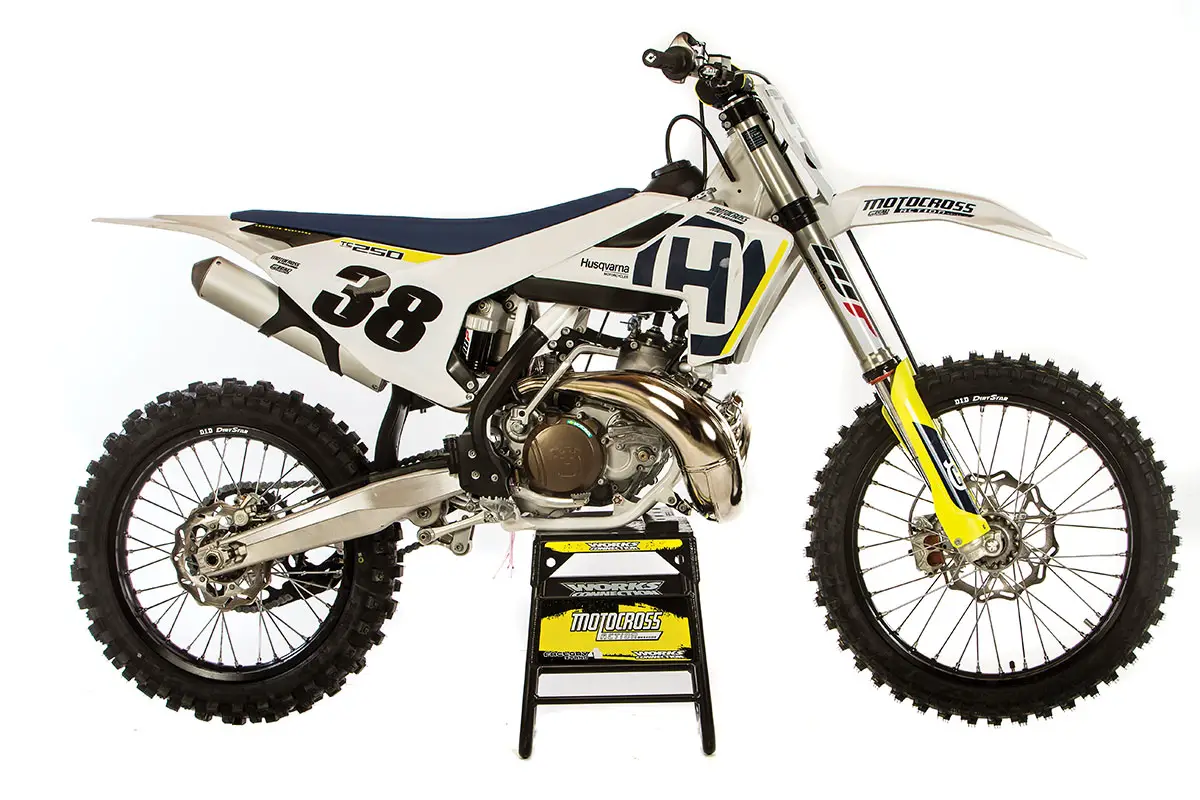
The 2018 Husqvarna TC250 is bare bones compared to a modern four-stroke. You can see through the frame, touch every part and, best of all, work on the two-stroke engine yourself.Q: WHAT CHANGES DID HUSQVARNA MAKE TO THE 2018 TC250?
A: There are four notable technical changes. Here is a recap of what Husqvarna changed on the 2018 Husqvarna TC250 two-stroke.
(1) WP AER fork settings. The 2018 WP AER forks have been updated with a new air seal, air piston and rebound spring on the air leg, along with a new piston on the damping side. For 2018, the compression damping has been firmed up in the mid-stroke. Last year’s AER fork had free-bleed around the compression shim stack, which made the damping too light in the mid-stroke, creating a high-speed flutter in consecutive braking bumps. For 2018 WP’s engineers addressed this issue; however, what they did to the 2018 forks was not rocket science, and any reputable suspension tuner can duplicate the mods.
(2) Shock. The valving on the WP rear shock has been modified to better match the re-valved front fork.
(3) Radiator guards. Husqvarna has redesigned the radiator guards to reduce the amount of trapped dirt on the bottom of the guard. The 2018 guards have holes in them to let dirt out. You can upgrade your 2017 radiator guards with a drill.
(4) Carb position. The carb is positioned at a 7-degree angle. If you looked at the engine from behind the carb, instead of being vertical, it would be tilted 7 degrees to help keep the fuel in the float bowl in the proper pickup position. Last year it was set at a 12-degree angle.
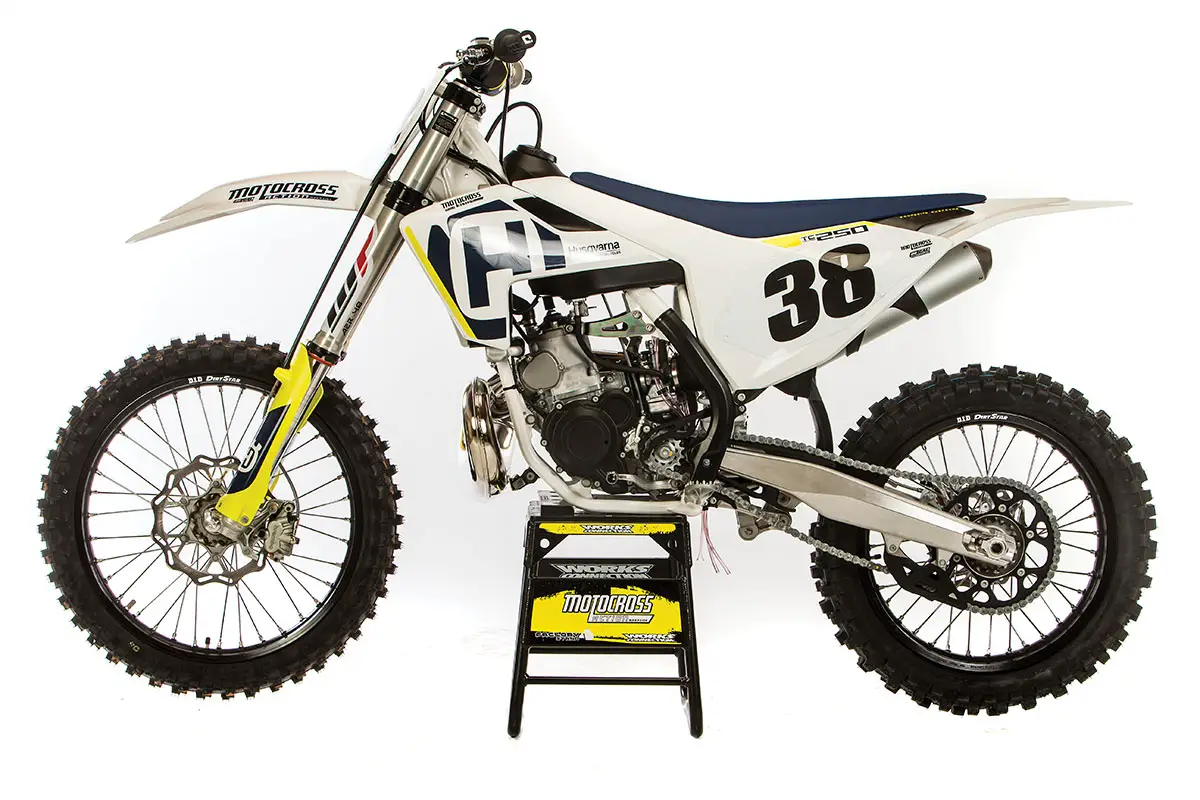
Q: HOW FAST IS THE 2018 HUSKY TC250?
A: This is an interesting two-stroke engine. It is so unique that old-school CR250, YZ250 and RM250 riders might not find it their cup of tea. How so? The Husqvarna TC250 has a strictly low-to-mid powerband. And we aren’t talking about a mellow, pleasant or easy-to-ride midrange powerband. Nope! The TC250 is blisteringly abrupt from the get-go. How powerful is it? It has an amazing 4 horsepower more at 7000 rpm than its prime Japanese-built competitor, the YZ250. This is a phenomenal horsepower number—and something that a talented two-stroke rider can really use to his advantage; however, a less talented rider is going to discover that from the snap of the throttle to the midrange, the TC250 is fast, abrupt and hard-hitting. Novice and Vet test riders thought it was too powerful. Pros loved it.
But, that is only one-third of what makes the Husqvarna TC250 engine so unique. The second part of the equation is that we weren’t lying when we said that it had a “strictly low-to-mid powerband.” As great as the low-to-mid-transition is, there is no transition to top-end power or over-rev after its 8200-rpm peak horsepower.
At high rpm, the 2018 Yamaha YZ250 is 4 horsepower more powerful than the Husky TC250. To clarify, the TC250 peaks at 8200 rpm, while the YZ250 peaks at 8800 rpm. Don’t think that the Yamaha YZ250 actually makes 4 more horsepower than the Husky TC250, because they make an almost identical 47 horsepower each. It’s just that the Husky makes it now (8200 rpm), and the Yamaha makes it later (8800 rpm). The lack of top-end power and over-rev are the hardest things for a rider to adapt to on the Husqvarna TC250—that and the really strong surge off the bottom. The TC250 has as a pure “gun-and-run” engine as you will find in motocrossdom. It has a hit-it-and-quit-it style of power. You must shift at 8200 rpm or it will fall on its face.
The third part of the Husqvarna TC250 equation is that it is the most tunable two-stroke engine ever made. Thankfully, we found a few simple changes that can make the powerband better for a wider range of riders. What follows is a primer on how to get more out of your 2017–2018 Husqvarna TC250 two-stroke.

Q: WHAT IS STEP ONE IN MAKING THE POWER MORE MELLOW?
A: If you have a pre-2018 TC250, you unplug the secret wire. Unlike the Husqvarna four-strokes, the Husqvarna TC250 two-stroke before 2018 do not come with an adjustable map switch, but what few people know is that it does have two maps. The stock map is the aggressive map, and it comes installed in the bike. There is a mellow map, but it is hidden under the gas tank. Look under the tank, just above the cylinder head, and you will see a wire hanging down with a white male/female connector. If you unplug that connector, you will activate the mellow map. A fair number of MXA test riders felt that with a little less jolt they could carry more speed out of corners without the drama, wheelies and wheelspin. On the 2018, you have a map swicth mounted next to the throttle that can switched back and forth between maps.

Q: WHAT IS STEP TWO IN MAKING THE POWER MORE ADJUSTABLE?
A: Adjust the power valve. On the starboard side of the engine (right side), in front of the clutch cover, you will find a brass power-valve adjuster. It is the only part on the TC250, or any other motocross bike on the planet, that calls for a square wrench (also known as a Robertson wrench). Since this is an odd tool, most TC250 or 250SX racers use a flat-bladed screwdriver wedged into the brass fitting to adjust the power valve. Yes, it does gnarl-up the brass to the point that a Robertson wrench will never fit again, but you gotta do what you gotta do. By turning the power-valve adjuster, you are able to adjust the preload on the power-valve spring, which changes the rpm at which the power valve’s flapper opens and closes. The power-delivery characteristics of the engine are affected by the timing and speed at which the power valve opens. The ideal power delivery isn’t necessarily the same for all riders or riding conditions, so many riders find it beneficial to alter the power-delivery characteristics to suit the available traction and their personal preferences.
Turn the adjuster counterclockwise for an aggressive hit and maximum top-end power. Turn the adjuster clockwise for smoother power and a broader range of tractable low-to-mid power. We recommend turning it a quarter-turn at a time (clockwise for a mellow delivery and counterclockwise for an aggressive delivery). Don’t be afraid to try a couple of settings to find what you like.
Q: WHAT IS STEP THREE IN GIVING THE TC250 A BROADER POWERBAND?
A: Change the gearing. The stock gearing on the 2018 Husqvarna TC250 is 14/50. Most MXA test riders felt that the gear ratios were a little off from gear to gear—not surprising on an engine that hits hard, hits now and signs off quickly. We killed two birds with one sprocket by gearing the TC250 taller. We switched from the stock 50-tooth rear sprocket to a taller 49-tooth sprocket. This smoothed out the power, lengthened the gap between gears and made the Husky TC250 feel like it pulled higher into the rpm range. It didn’t actually make its power at a higher rpm, but it took longer for the gears to get to the peak horsepower, which was at a fairly low 8200 rpm. We recommend this change, even for our happy-as-a-lark Pro test riders.

Q: WHAT IS STEP FOUR IN IRONING OUT THE TC250’S POWER DELIVERY?
A: This will confuse you as much as it confused us. Last year, when Husky and KTM switched from Keihin PWKs to Mikuni TMXs, we struggled with the jetting. The factory technicians shocked us by saying that we should quit running a 40:1 gas/oil ratio and switch to 60:1. In fact, the TC250’s owner’s manual says to run a gas-to-oil ratio of 60:1. We thought it was a typo, but the engineers insisted that it would solve all of our jetting issues (and promised that they would rebuild our engine if they were wrong). So, we switched from Maxima at 40:1 to Maxima at 60:1 (with the stock jets installed). The 60:1 ratio, which is 10.7 ounces of oil to 5 gallons of gas, was an improvement; however, we still had to fiddle with the brass for temperature, humidity or track changes.
Strangely, when we started testing our 2018 Husqvarna TC125, the engineers told us to change the gas/oil ratio again. They want Husky TC125 owners to run 50:1 and TC250 owners to run 60:1. We admit that the 60:1 ratio is better.
Q: WHAT IS STEP FIVE IN SEEKING MORE TOP-END POWER?
A: No matter how you slice it, the 2018 TC250 would be a better all-around engine if it kept its hyper-low-to-mid transition but added the “big three”—more peak horsepower, more top-end and more over-rev. We didn’t have to look far to find the solution. It was the same solution that Jeremy McGrath found when he had his brief fling with KTM back in 2003. The Pro Circuit “Jeremy McGrath pipe” has been a staple of KTM owners since Mitch and “SuperMac” conceived its dimensions—albeit updated with each new engine configuration.
Bolting the Pro Circuit pipe and silencer onto the 2018 Husqvarna TC250 is worth almost 3 horsepower. And, all of that gain comes from 7000 rpm to 9500 rpm. In short, the Pro Circuit pipe ups the peak horsepower, adds more power on top and increases over-rev by 500 rpm.
Q: HOW DOES THE 2018 HUSQVARNA TC250 HANDLE?
A: The Husqvarna TC250 is the best all-around-handling two-stroke on the track. Unlike a four-stroke, which must follow the prescribed four-stroke line (and can’t deviate from it), a TC250 can change lines in an instant. You can rail a berm and then break out of it early to go up the inside. Two-strokes, by their very nature, are cut-and-thrust handlers. They don’t need to run automobile lines around a track, because they have the instantaneous power to change direction on a whim. And since the Husqvarna TC250 is 27 pounds lighter than the Suzuki RM-Z450 (the tightest-turning of the four-stroke models), it is more of a flick of the bars than a concerted effort. Two-strokes aren’t bound by the front-wheel steering rules of a four-stroke. Plus, Husqvarna’s chromoly steel chassis is exponentially better with a two-stroke engine than it is with a four-stroke engine. It can make instantaneous cuts in places a four-stroke never imagined going.
You need to carefully dial in the fork-leg height before making any radical cuts. Slide the forks up in the clamps to turn tighter and down in the clamps for more stability. One millimeter in either direction can make a big difference.

Q: HOW GOOD ARE THE WP AER AIR FORKS?
A: Husqvarna’s WP AER air forks are simple to live with. The recommended pressure is listed on a sticker on the fork stanchion in bar (but the WP air pump converts bar to psi and kg/mm). The stock air pressure is 147 psi. Most MXA test riders run lower air pressures than what is suggested by WP. Before you go out to ride, put an O-ring around the right fork leg and set the compression and rebound clickers on 12 and 12. After doing a couple of laps, look at the zip-tie. If it is not within 1-1/2 inches from bottoming, lower the air pressure by 2 psi and ride again. Keep lowering or raising the air pressure until you get within 1-1/2 inches of bottoming. Write down this air pressure number and turn your attention to the compression clickers. Don’t be afraid to make big swings in the number of clicks. Try everything from 6 out to 25 clicks out. Somewhere along the way you will find your sweet spot.
The key is to find the right air pressure for your speed, weight and track, and stick with it. From that point on, all adjustments should be done with the clickers.
Q: HOW MUCH DOES A 2018 HUSQVARNA TC250 COST?
A: The TC250 costs $7999, which is $100 more than the KTM 250SX and $600 more than the Yamaha YZ250.
Q: WHAT DID WE HATE?
A: The hate list:
(1) Gearing. The best all-around fix for Novices and Vets is to gear it up one tooth.
(2) Fork-air bleeder. Even if you own a #20 Torx wrench, never use it on the air side of the WP forks. It will strip out. Just use a 10mm T-handle. On the left side, you have to use the #20 Torx.
(3) Gas cap. It sticks. We aren’t kidding.
(4) Sprocket bolts. Watch the sprocket bolts closely. They come loose all the time (Loc-Tite or not).
(5) Spokes. We check the spokes constantly.
(6) Frame guards. Why paint the frame white if you are going to cover the most visible parts with full-length black frame guards?
(7) Fork compression clicker. If the clicker arms were longer, the compression could be adjusted with one finger.
(8) Air-fork Schrader valve. The position of the WP AER fork’s air valve is hard to reach, and the valve-stem cap almost always falls into the recessed fork cap.
(9) Front master cylinder hose. If you hook metal tie-down hooks onto your handlebars and hit a bump in the road, the tie-down hook can crimp the metal tube that comes out of the front master cylinder.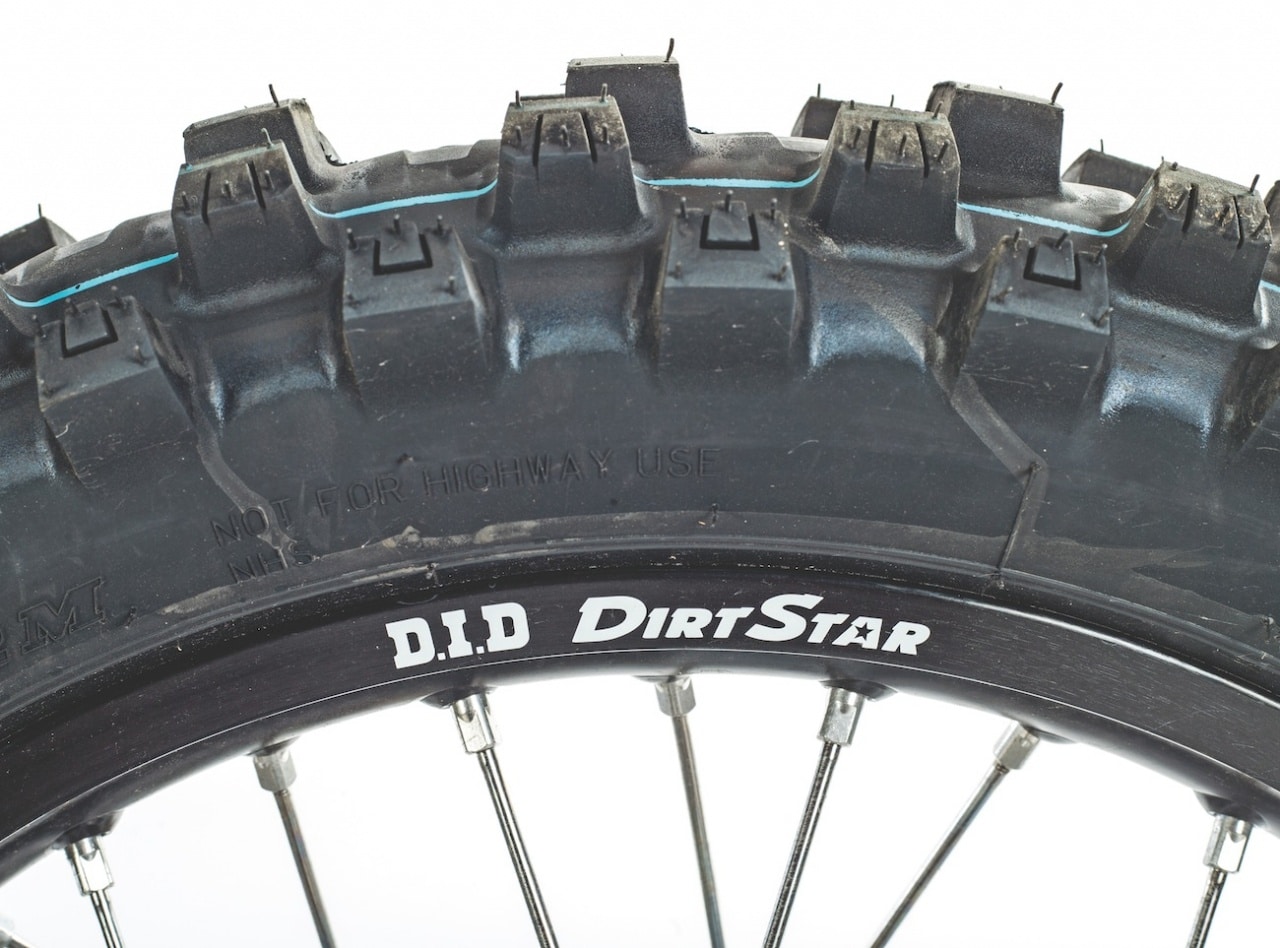
Q: WHAT DID WE LIKE?
A: The like list:
(1) Power valve. The power valve is a great way to refine the power delivery. But, order a $95.00 Kreft PowerDial 2.0 so you can make incremental changes in seconds—without the need for a Robertson wrench.
(2) Weight. The 2018 Husqvarna TC250 is 5 pounds lighter than a YZ250.
(3) Brakes. The fact that these are the best brakes, even on a heavy four-stroke, means that they are super on the much lighter two-stroke.
(4) Hydraulic clutch. Husqvarna’s self-adjusting, hydraulic, Belleville washer clutch is the future of motocross clutches.
(5) Airbox. We don’t think changing an air filter could get any simpler.
(6) Tires. The TC250 comes with our favorite tires, the Dunlop Geomax MX3S’.
Q: WHAT DO WE REALLY THINK OF THE TC250?
A: The American motocross market is only served by four 250cc two-strokes—Husky, KTM, Yamaha and TM. The four brands vary in their design philosophies, powerbands, suspension setups and handling. The differences are what make them unique, but the adjustability of the Husky and KTM set them apart. They are brutally fast but can be made mellow. We think there is a setting for everyone.
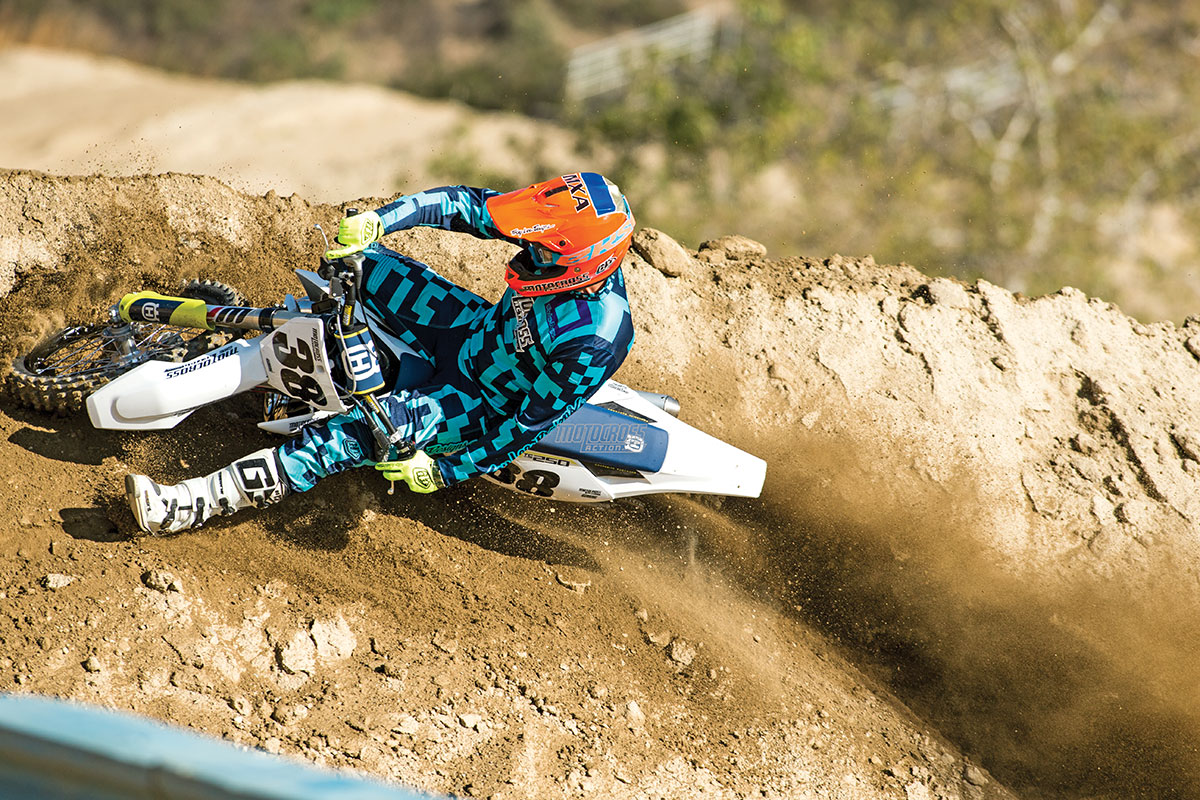
MXA’S 2018 HUSQVARNA TC250 SETUP SPECS
This is how we set up our 2018 Husqvarna TC250 for racing. We offer it as a guide to help you find your own sweet spot.
WP FORK SETTINGS
As a general rule, first find an air pressure that you like, then start adjusting the clickers. We recommend adjusting the air pressure in 2-pound increments. While the stock air pressure is 147 psi, we had riders who liked it as low as 143 psi and as high as 154 psi. With only one air pressure adjustment, changes can be made in half the time it takes to adjust a Showa or Kayaba air fork. Plus, KTM gives you a digital air pump when you buy the bike. It’s easy to find your happy place. These are the settings we ran on the 2018 Husqvarna TC250 (stock settings in parentheses):
Air pressure: 144 psi (147 psi)
Compression: 23 clicks out (12 clicks out)
Rebound: 19 clicks out (12 clicks out)
Fork height: 2nd line
Notes: On big hits at pressures below 144, the forks might bottom out (but if you like the feel, you can add 5cc of oil to stop the bottoming). Anything above 144 and our test riders had no issues with bottoming resistance.
WP SHOCK SETTINGS
The Husqvarna shock has a good setting. We spent most of our time dialing in the forks, although sag played a big part in balancing out the bike. We were all over the map, going as low as 115mm and as high as 100mm. Most test riders split the difference at 107mm, although the sweet spot is between 102mm and 108mm, depending on the rider and track. For hardcore racing, we recommend this shock setup for the 2018 Husqvarna TC250 (stock specs are in parentheses):
Spring rate: 42 N/m
Hi-compression: 1-1/4 turns out (2 turns)
Lo-compression: 8 clicks out (15 out)
Rebound: 14 clicks out (15 out)
Race sag: 107mm (110mm)
Notes: The 42N/m shock spring is lighter than what comes on the Husqvarna four-strokes, so use free sag to determine if the spring rate is proper for your body weight. You want free sag to be between 30mm and 40mm.
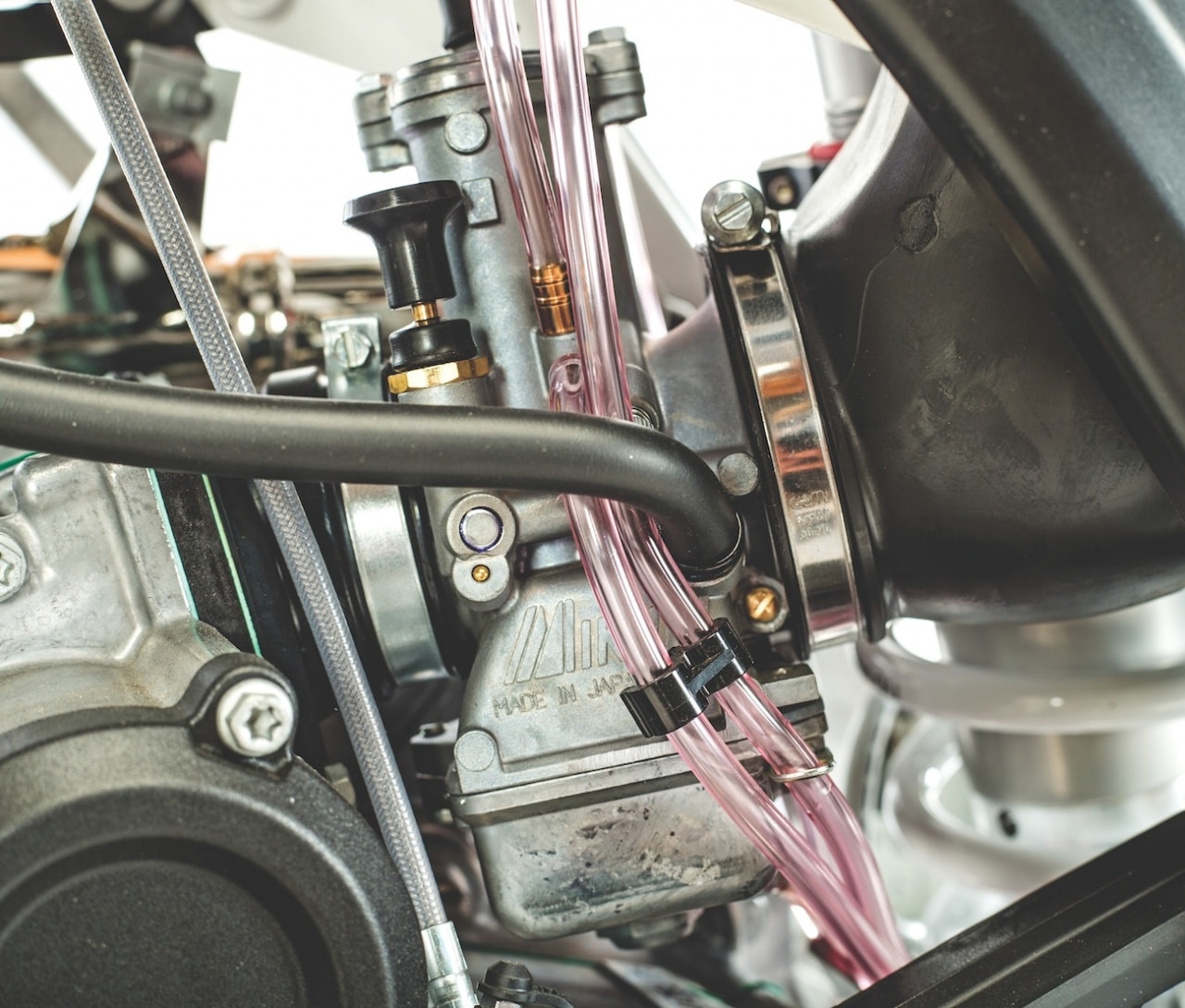 MIKUNI TMX 38 JETTING SPEC
MIKUNI TMX 38 JETTING SPEC
Here’s what we ran in our 38mm TMX (stock settings in parenthesis).
Main jet: 450 (440)
Pilot: 45 (42.5)
Needle: 43-73
Clip: 3rd
Air screw: 1/4 turn out (1-1/2 turns out)
Notes: We ran the gas/oil ratio at 60:1, but if you are good at jetting, you should be able to get it into the sweet spot with basic jetting techniques with your favorite fuel ratio.
THE GEAR:
Jersey: Troy Lee Designs GP Air Maze
Pants: Troy Lee Designs GP Air Maze
Helmet: Troy Lee Designs SE4
Goggles: EKS Brand GOX Flat Out
Boots: Gaerne SG12


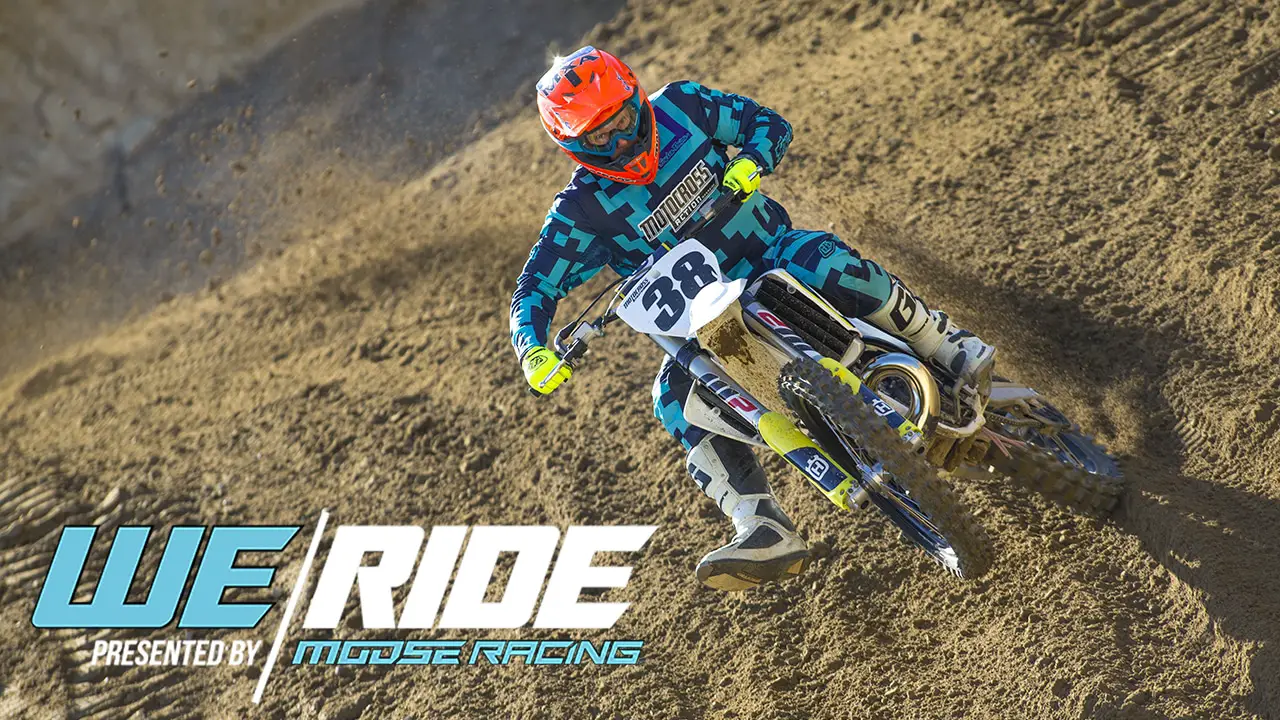

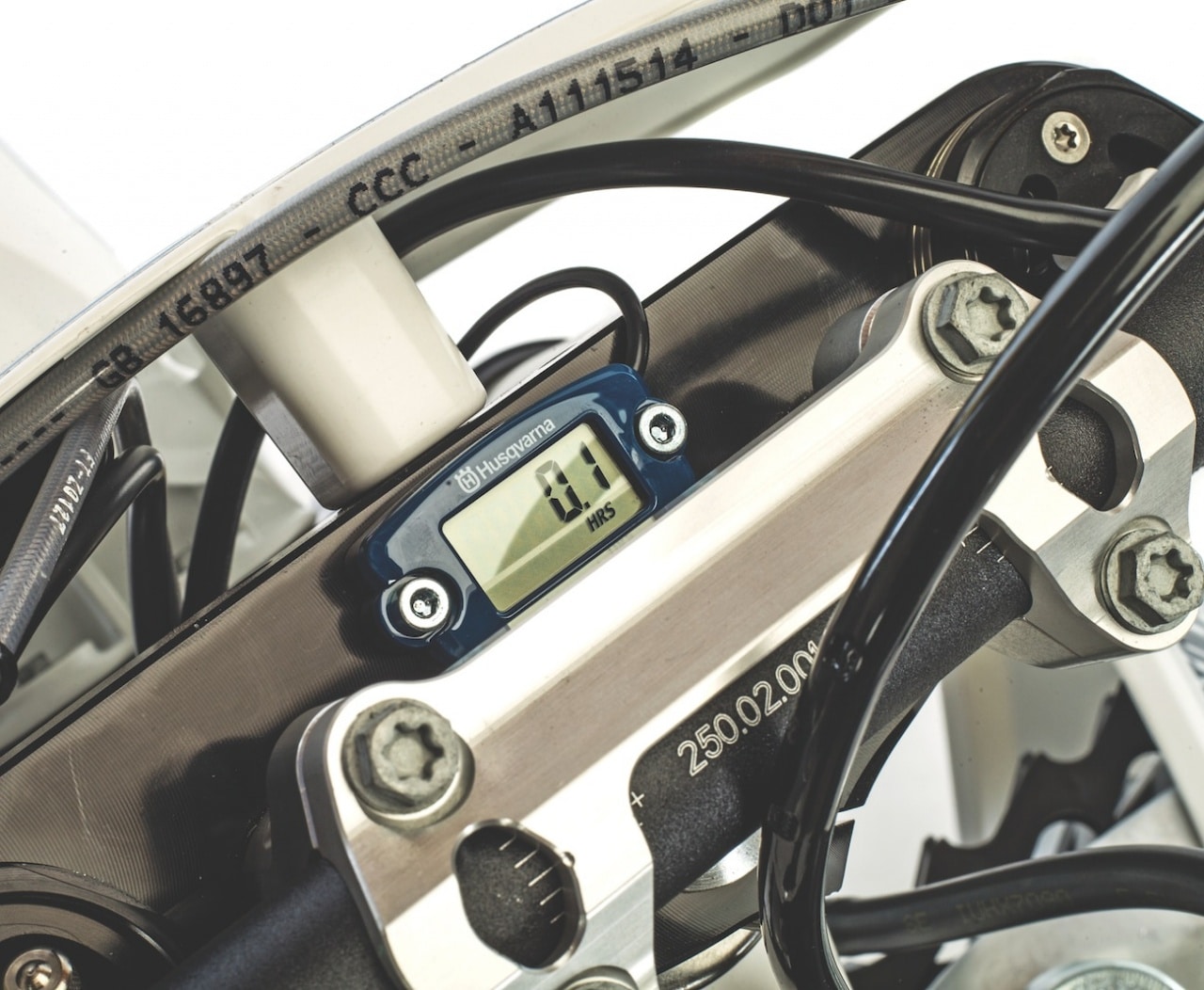



Comments are closed.